Dimmer for LED strip: types, which one is better to choose and why
In recent years, the demand for LED strips as a light source has become higher.And there is nothing surprising here - their functionality, efficiency and durability often exceed those of conventional lamps.
In addition, any interested person will be able to further expand the capabilities of this lighting source by purchasing a dimmer for LED lamps. We will tell you what it is and tell you how to choose this device correctly. Do-it-yourselfers will find valuable installation tips from us.
The content of the article:
What is a dimmer?
This is an electrical device designed to control the brightness of all kinds of LED strips, mostly single-color ones. Why is it installed in a circuit?
The installation location can be any, but the connection should only occur between the power supply and the light source used.
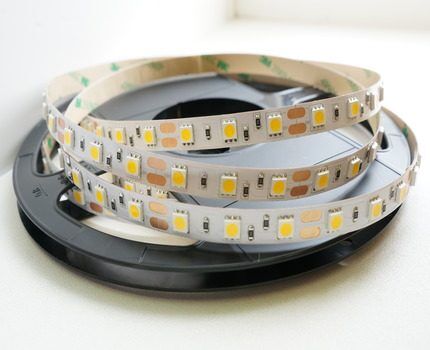
This sequence is determined by the fact that lighting devices operate in the presence of a voltage of 12 or 24 Volts, therefore Dimmer must have similar characteristics.
As a result, it should be placed behind the power supply, which converts standard 220 V to the required parameters, and in front of the LED strip in order to be able to control its glow.
Popular device types
In fact, there are no standards or strict norms regulating the division of dimmers. Therefore, any such procedure is considered conditional.Nevertheless, for convenience, two main subtypes of modern brightness controllers are distinguished.
Namely, they are divided into the following:
- analog — allow you to change modes by slightly decreasing/increasing the voltage;
- digital — in this case, to control the LED strip, pulse-width modulation is used, which is a sequence of command signals of different durations, which leads to a change in brightness.
Since each of these options has its own advantages and disadvantages, manufacturers sometimes supply the market with combined analog-digital dimmers. They are more effective and have fewer disadvantages than devices belonging to certain types. But the cost is significantly higher, so such products are far from the most popular.
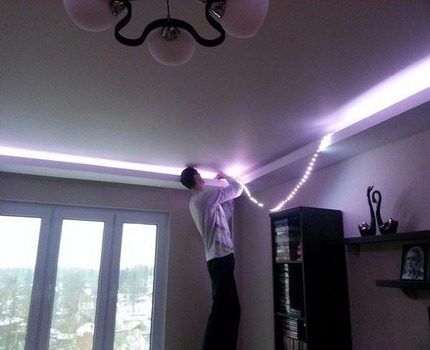
Devices belonging to both subtypes can solve various problems, which, in addition to brightness control LED backlight, is to reduce energy consumption.
Moreover, tangible results are achieved in premises for various purposes: commercial, residential, any other. In any case, you can reduce energy consumption by a significant 30-35%.
Besides, dimmers for LED devices have the following advantages:
- They increase the service life of the LED strips used - reducing the load reduces the likelihood of lighting fixtures overheating, which is one of the main reasons for reducing their service life. But only digital models can please owners with such opportunities.
- They provide convenient control of the LED strip - remote controls are often used to increase comfort. Additionally, various signal transmission options are available.
- They make it possible to create color effects and illumination.
- Allows the tape to be used in conjunction with security systems for buildings and premises. For example, brightness controls are often connected to volume sensors and if they are triggered, the LED strip immediately turns on, which scares off intruders.
Often, dimmers with lighting devices are used to simulate the presence of owners in an apartment or house - this is done to mislead criminals.
An important factor is the possibility of programming and durability with proper use. At the same time, analog and digital dimmers have a number of features unique to them that you should know. This will help make a choice that the buyer will not have to regret.
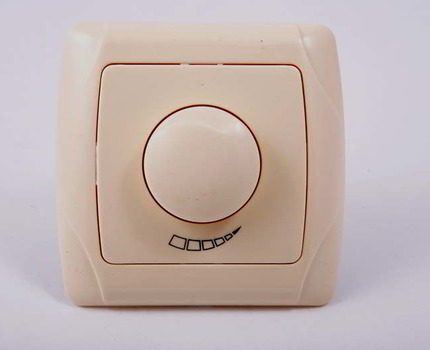
Analog devices provide LED strips with a stable supply current. In this case, power losses will be relatively small.This type has only one drawback, but it is a very important one - they, unlike digital analogues, significantly heat the LED strip, which does not contribute to durability.
In addition, increased temperature leads to a decrease in the quality of lighting, which results in a change in the color temperature provided by the manufacturer. This fact will not please the owner, who chose the tape taking into account his taste.
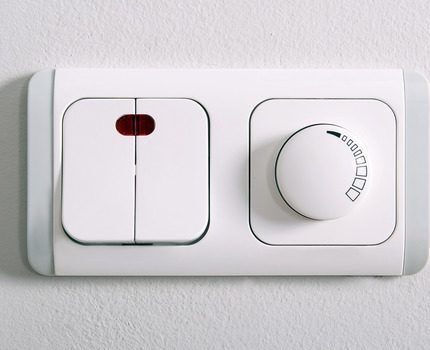
Digital fixtures provide any LED strip with ideal operating conditions. As a result, power loss will be minimal, and the supply current is stable.
The same can be said about the characteristics of the glow spectrum. That is, a person who bought a strip with LEDs can be sure that its color temperature will not change during operation. And this has a beneficial effect on its durability.
Only cheap regulators of this type can have a significant drawback. The reason is that they cause LED flickering, this leads to eye fatigue, headaches, and a noticeable decrease in performance. That is, you should not skimp on quality.
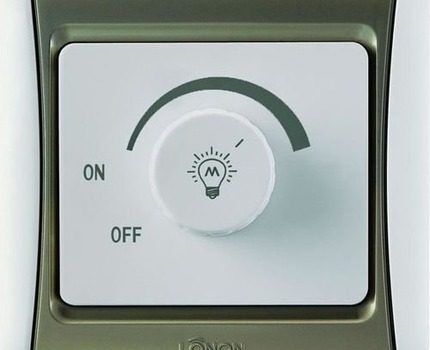
In addition, devices are divided according to a number of important characteristics. This is done in order to make the choice easier, so the future user should familiarize themselves with such information.
Subtleties of device control
For convenience, control is carried out in various ways. There are several of them and each has its own advantages and disadvantages, which can significantly affect the comfort of use, cost and even prestige.
According to their characteristic features, dimmers are:
- push;
- rotary;
- rotary-press;
- electronic;
- sound;
- remote.
All industrially produced pressure products are as similar in principle to traditional ones as possible. modernized switches. The necessary manipulations, in this case, are performed by pressing or holding the key.

The rotary type is distinguished by the presence of only one control element, which is the regulator. All manipulations are carried out by moving it left and right. For convenience, a scale is sometimes applied to the surface of the panel, which allows you to make the necessary settings more accurately and quickly.
All kinds of rotary-push options are hybrids of the previous two types. As a result, the on/off procedure is performed by pressing as usual, and brightness adjustment is performed by turning.
All of the above subspecies are mechanical. They do not have any significant disadvantages, in addition, their cost is the most affordable. But control using these dimmers is not as convenient as when using devices belonging to other groups.
Electronic regulators are controlled using sensors; they do not have any other significant differences from their mechanical counterparts.But a more modern appearance, and in some cases the presence of an informative display, makes this variety increasingly in demand.
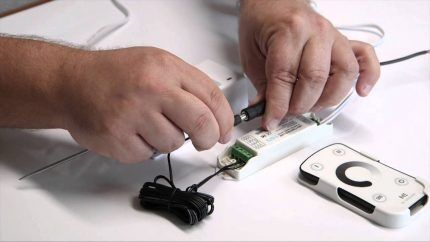
Dimmers controlled by audio signals have a built-in sensor that responds to any noise that exceeds the level set by the manufacturer or the owner himself. A person can give the command to turn on/off in any way he likes, for example, by clapping, speaking and other similar methods.
Devices of this type are no less reliable and effective than all the others, but they are not practical enough. Since they will periodically be triggered by sounds made by a TV, stereo system or normal conversation in a raised voice.
This is not entirely convenient, but with the exception of one case, which are noisy parties - the device, which receives commands from sound signals, also responds to loud music, so it will completely replace light music, since the illumination will be of a decent level.
But for the sake of a rare vacation, there is hardly a need to buy a device that functions in this way. Although the way out may be to use combined control.
Remote control is carried out using familiar remote controls. They are often included in the delivery package and make it possible to perform the necessary manipulations from a convenient place. This option is comfortable, although the buyer will have to pay more money than for a mechanical analogue.
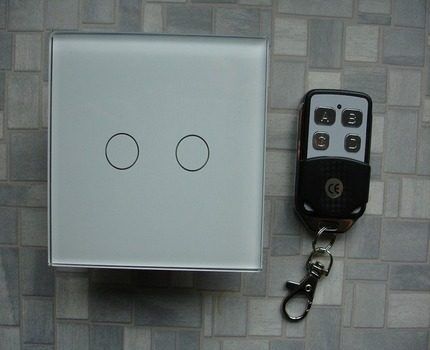
The most common and popular are remote controls that transmit a command signal using an infrared beam. But a potential buyer should know that he can purchase a device that also performs its functions using radio signals.
With this remote control you can perform control from various places in the building and even outside it. Whereas an infrared beam can effectively cope with its work only when it is precisely aimed at a sensor that receives a signal within one room.
This is a significant advantage, but for the ability to control the glow using radio signals you have to pay more, and much more. In addition, remote controls are touch-sensitive or push-button. Neither type has any obvious advantages or disadvantages over the other. Although touch devices are more modern.
Remote control can also be performed using smartphones and tablets. To do this, the dimmer must receive command signals transmitted via Wi-Fi. In this case, the brightness of the glow can be adjusted from anywhere.

Users also have the opportunity to perform the necessary manipulations using a computer. To do this, you need to make a wired or wireless connection to the specified device.
Today, dimmers, which can be controlled in several ways, are becoming increasingly popular. For example, using keys and remotely using one of the types of remote controls. Mixed control is called combined and it is reliable and practical.
Types of devices by installation method
To solve various problems and simply to increase comfort, modern brightness controllers can be mounted in different places. In addition, this feature makes them more convenient to operate.
Dimmers are as follows:
- invoices;
- built-in;
- modular.
The easiest to install are surface-mounted devices, which are similar in shape and size to conventional switches and are quite capable of replacing them. Their installation procedure is also similar, and the control principle is similar.
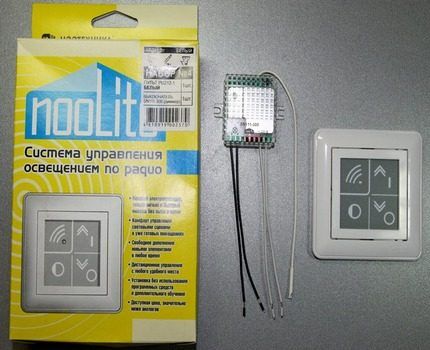
The main feature of all kinds of built-in dimmers is that they are mounted in a distribution box or a specially made niche. As evidenced by the very name of this variety.
Modular devices are designed to be installed in electrical panels on DIN rails. This feature is due to the fact that they are large in size and high in power. Which in everyday life allows them to be used to control several supply lines at once.
The future user should remember that modern dimmers, regardless of the type of installation, are connected to or built into a circuit between the LED strip itself and its power supply.
That is, there cannot be another option, which must be taken into account for ease of installation and management. It is also common to see regulators divided according to the number of working channels and the protocol used.
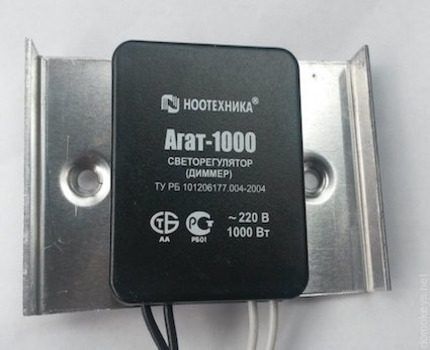
But, in most cases, this is of little interest to the ordinary user, since structurally complex models are rarely used in domestic conditions, small commercial and office premises due to their considerable cost.
Rules for choosing the optimal option
Buyers can purchase two types of LED strips, the so-called monochrome, that is, one-color, or three-color RGB. In the latter case, all colors can be connected separately, mixed, and obtained different effects.
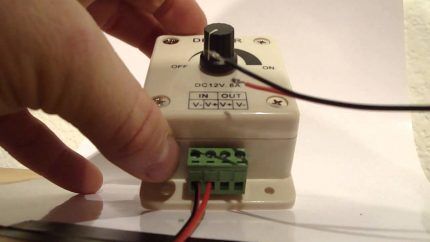
And the future owner should know that to control a multicolor ribbon you will need to purchase a special RGB controller. Since the controller’s capabilities are not enough to fully control such a light source.
In addition, you need to carefully consider the technical parameters of the device. Since the power of any control device must exceed that of the LED strip itself, it is necessary to take this feature into account before purchasing.
Moreover, the options may be as follows:
- If the owner of the premises does not plan to further increase the length of the LED strip, and, consequently, its power, then this characteristic of the dimmer should be higher by 20-30% and this is at least, and best of all, half.This will help extend the life of the regulator, eliminating the possibility of rapid wear and subsequent breakdown.
- If you plan to increase the power of the LED strip, then the device must be purchased with this in mind. Or later you will have to spend money on purchasing a new regulator again. Moreover, the power reserve should be calculated taking into account the required 20-50% for the reserve.
When a potential buyer incorrectly calculates the power, the device will not be able to perform its functions, so it simply will not turn on. And this is with the most favorable outcome, since it often happens that overload leads to instant failure.
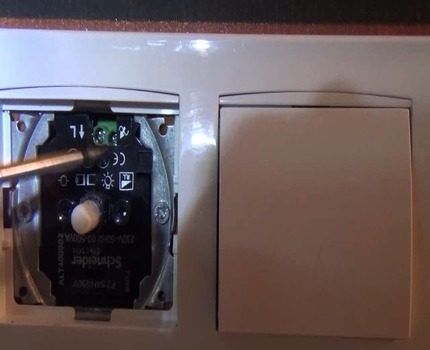
In addition, it is important to decide on the type of control. Any of them (mechanical, electronic, remote) is reliable and will allow a person to effectively manipulate the brightness of the LED strip.
Therefore, everything will depend on how much a person is willing to pay. If he decides to save money, then the most affordable model with a mechanical control type will be the optimal solution.
When the future user has more funds at his disposal, then preference should be given to a device with an attached remote control. Because it increases comfort, which is a significant advantage.
In addition, when choosing, you should not skimp on the quality of the dimmer; it should only be from a well-known manufacturer. Which are the companies Osram, Gauss, Philips, and a number of others.
If you still want to reduce costs and purchase a Chinese product, then it is worth remembering that such a purchase can result in headaches, loss of some ability to work, and a number of other health problems. The remaining features when choosing are not so important and everything depends only on personal preferences.
Those wishing to collect DIY dimmer You will receive detailed instructions on our website. We recommend that you read this very useful article.
Conclusions and useful video on the topic
The first video will give a person the opportunity to get to know the regulators better and learn some of their features:
The following video provides information that allows you to better understand the advantages of remote control and understand how it is performed:
The video will help you figure out how to improve the functionality of LED strips and learn about the advantages of sensors:
A dimmer, designed to regulate the brightness of strips, is a practical device that can significantly reduce energy consumption in any room, as well as increase comfort in it. But for this, a person needs to make the right choice and not forget that the desired result will be obtained only by purchasing a quality product.
Please write comments, ask questions, and post photos in the block below. Tell us about how you selected a dimming device for LED strip lighting in your own home/apartment. It is possible that your recommendations will be useful to site visitors.




I am a designer, I constantly need to use LED strip.Unfortunately, I cannot say that this is an excellent light source; most likely, I will classify it as additional lighting, in which it is not recommended to read. In decor, this thing is simply irreplaceable. You can choose absolutely any diameter and dance to it. Most often they choose analog, but digital is great)
I took a three-color Erjibi, but no one even told me about the controller. Of course, a self-service store: cash register, no consultants. As a result, then at home on the Internet I figured out what was what. I purchased it with 25% more power, I did not increase the tape. But here’s what I can’t understand: some write that if one color flies, the entire tape will be covered, and some write that there will only be two colors left to work with. Why such disagreements?!
The disagreement comes from the fact that on the Internet many confidently write about things about which they have a superficial understanding. If one color fails, the other two will continue to work.
Even here on the site there are people who confidently state things that are simply impossible or in reality everything is exactly the opposite. I'm not even talking about other non-core resources in the form of city or general thematic forums.
Regarding your case, you don’t have to worry: if one color burns out (I don’t even know what needs to be done to make one of the tapes inoperative), the rest will continue to work properly. This is what the engineers, who know this matter first-hand, thought through.
As for the power of the dimmer itself, you have more power in terms of power and that’s right.If the strip power were greater than the maximum that the dimmer is designed for, this would be a very serious problem. For a tape of one color, I also read about the misconception that if one diode burns out, the entire tape will stop working.
Tell me please. I bought a 24 volt tape 10 watts per meter. 17 meters. That turns out to be 212 watts. There is a dimmer with an output power of 240-480 watts. Will everything work correctly?